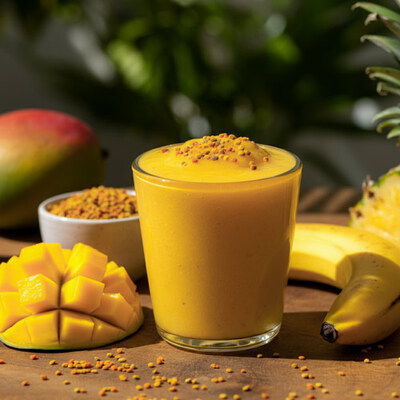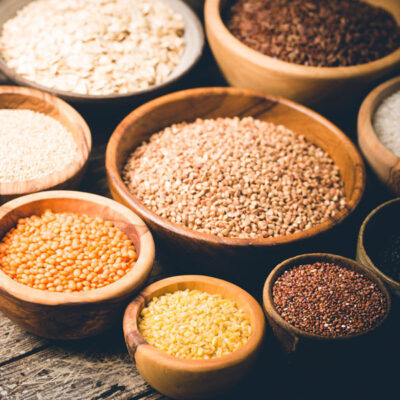Bee Pollen Smoothies: Make Your Menu Shine with Nature's Golden Superfood
Author: Admin Date Posted:27 October 2025

Ready to create a buzz? Three commercial bee pollen smoothie recipes for cafes. Includes sourcing tips, nutritional benefits, and practical marketing strategies.
Read time: 7 minutes
Looking at those golden granules topping smoothie bowls across Australian cafes? That's bee pollen, and if you're not yet offering it to your health-conscious customers, you're missing an opportunity to differentiate your menu with minimal effort.
For cafe owners and dessert bar operators, bee pollen delivers exactly what modern customers want: visual appeal, genuine nutritional benefits, and an ingredient story worth sharing. It's the sort of addition that transforms a standard smoothie into something memorable without disrupting your workflow or requiring specialist training.
The superfood category continues growing in Australian hospitality, and bee pollen sits perfectly within this trend—easy to source, simple to use, and genuinely beneficial. Let's explore how to incorporate it into your offerings with three distinctive smoothie recipes designed for commercial success.
Understanding Bee Pollen: What Makes It Special?
Bee pollen consists of tiny granules collected by honeybees as they visit flowers, mixed with nectar and enzymes to create a nutrient-dense food source. Beekeepers harvest small amounts from hives without disrupting bee colonies, which makes it a sustainable ingredient choice for cafes committed to ethical sourcing.
The nutritional profile explains its growing popularity. Bee pollen contains over 250 bioactive compounds, including all essential amino acids—making it a complete protein—along with B vitamins, vitamins C and E, minerals like iron and zinc, plus antioxidants such as flavonoids and phenolic acids. Research published in peer-reviewed journals confirms its anti-inflammatory properties, immune-supporting compounds, and potential benefits for energy metabolism.
The flavour profile is distinctive without being overpowering: mildly sweet with floral notes and a subtle honey-like quality. The texture adds a pleasant, delicate crunch that works beautifully as both a blended ingredient and a visual garnish.
Most importantly for cafes, it's remarkably versatile. Bee pollen enhances tropical smoothies, complements green blends, and works equally well with dairy, plant-based milks, or yoghurt bases. The golden colour photographs beautifully for social media, which matters significantly in today's visually-driven cafe culture.
Three Commercial Smoothie Recipes Using Bee Pollen
1. Tropical Sunrise Smoothie
This vibrant blend capitalises on Australia's enduring love for tropical flavours whilst showcasing bee pollen's golden hue. It's particularly suited to warmer months and appeals to customers seeking refreshing, energising options.
Ingredients (yields one 450ml serve):
- 150g frozen mango chunks
- 80g frozen pineapple chunks
- ½ medium banana (approximately 60g)
- 120ml coconut water (substitute regular filtered water if preferred)
- 2 tablespoons Greek yoghurt (or coconut yoghurt for vegan menus)
- 1 teaspoon bee pollen (for blending)
- Additional bee pollen for garnish
Method:
- Combine frozen fruit, banana, coconut water, and yoghurt in your commercial blender
- Add a teaspoon of bee pollen to the blend
- Process on high speed until completely smooth, adjusting liquid if needed for consistency
- Pour into a serving glass
- Garnish generously with bee pollen granules on the surface
Service notes: The yellow-on-yellow colour contrast creates a striking visual appeal. This smoothie works well with both clear and opaque serving cups, though for cafes with Instagram-focused customers, consider serving in a glass cup to showcase the colour gradient.
2. Green Energy Smoothie
Green smoothies remain consistently popular in Australian cafes, particularly with fitness-conscious customers and lunch crowds. This recipe balances earthy greens with natural sweetness whilst maintaining a velvety texture that keeps customers coming back.
Ingredients (yields one 450ml serve):
- 40g fresh baby spinach (approximately 2 large handfuls)
- ½ ripe avocado (approximately 60-70g)
- 1 Granny Smith apple, cored and roughly chopped
- 60g cucumber, chopped
- 250ml unsweetened almond milk (or filtered water for lighter texture)
- Juice of ½ lime (approximately 1 tablespoon)
- 1 teaspoon bee pollen (for blending)
- Additional bee pollen for garnish
- Optional: fresh mint leaves for additional garnish
Method:
- Place all ingredients except garnishes into a commercial blender
- Add a teaspoon of bee pollen
- Blend on high until completely smooth—the avocado creates a luxuriously creamy texture
- Pour into a glass or smoothie bowl
- Top with bee pollen granules, and mint if using
Service notes: The golden bee pollen creates a beautiful contrast against the vibrant green base. For bowl service, consider adding additional toppings like granola, coconut flakes, or sliced kiwi to create an "Instagrammable" presentation that encourages social sharing.
3. Berry Açai Protein Blend
This recipe taps into the ongoing açai bowl trend whilst adding protein for post-workout customers and afternoon energy seekers. The berry-bee pollen combination is both flavourful and photogenic, making it an excellent addition to your breakfast or recovery menu.
Ingredients (yields one 450ml serve):
- 100g frozen mixed berries (strawberries, blueberries, raspberries)
- 1 packet açai puree (typically 100g, frozen)
- ½ medium banana
- 150ml coconut milk (or oat milk for a creamier result)
- 1 tablespoon almond butter (or protein powder alternative)
- 1 teaspoon bee pollen (for blending)
- Additional bee pollen for garnish
Method:
- Combine frozen berries, açai puree, banana, milk, and almond butter in a blender
- Add a teaspoon of bee pollen
- Blend until thick and smooth—açai should create a soft-serve consistency
- Pour into the serving vessel
- Garnish with bee pollen and optional fresh berries
Service notes: This works particularly well as a thick smoothie bowl. The deep purple base makes the golden bee pollen pop visually, creating an eye-catching contrast that photographs beautifully. Consider offering as part of your breakfast or post-workout menu to capture health-conscious morning and afternoon crowds.
Sourcing and Storage Considerations
Getting your bee pollen supply right makes all the difference to both quality and profitability.
Quality sourcing: Source your bee pollen from reputable Australian suppliers. Consider the appeal of local Australian bee pollen to customers interested in supporting regional producers. The local angle often resonates strongly with cafe customers who value transparency and community connection.
Here at Opera Foods, our own brand Boost Nutrients Australian Bee Pollen is sourced from producers that keep their honey “wild and raw” by keeping their bee hives in the bush and more than 6 kilometres from any crops grown with pesticides.
Storage: Store bee pollen in airtight containers in a cool, dark location. Refrigeration extends shelf life to approximately 12 months whilst maintaining quality. Avoid moisture exposure, which can cause clumping and degradation. For busy service periods, keep a small amount in an easy-access container at your prep station whilst storing the bulk supply properly.
Portion control: One teaspoon per serve provides sufficient nutritional benefit and flavour whilst helping control costs. Bee pollen typically ranges from $40-80 per kilogram, depending on quality and supplier, so consistent portioning protects your margins.
Allergen considerations: Bee pollen may trigger reactions in customers with pollen allergies or bee sting sensitivities. Train staff to ask about allergies when customers order bee pollen items, and clearly mark it on menus with standard allergen warnings to meet duty of care requirements.
Don't forget that, just like honey, bee pollen is not suitable for vegans.
Marketing Your Bee Pollen Smoothies
Having great recipes is only half the battle—you need to communicate their value effectively.
Menu Descriptions That Sell
Generic descriptions don't capture attention or justify premium pricing. Instead of "Mango Smoothie," create compelling names with benefit-focused descriptions like this:
"Tropical Sunrise Bowl – Energising mango, pineapple and coconut water blend supercharged with nutrient-rich bee pollen. Naturally rich in complete protein, B vitamins and antioxidants."
Notice the structure: evocative name, key ingredients, followed by specific benefits. This format works across menu formats and helps staff communicate value to customers who ask, "What's special about this one?"
Staff Training Essentials
Your team should understand bee pollen beyond "it's healthy." When you provide clear talking points, staff can confidently recommend these items and answer customer questions:
- "Bee pollen contains all essential amino acids, making it a complete protein source"
- "It adds a subtle, sweet floral taste with a delicate crunch"
- "The golden granules are collected sustainably by Australian beekeepers"
- "It's packed with B vitamins, antioxidants, and minerals that support energy and immunity"
Make sure all staff have actually tasted your bee pollen smoothies. Personal experience enables authentic recommendations that convert curious customers into purchasers, whilst generic script-reading rarely does.
Visual Marketing
Bee pollen smoothies are inherently photogenic, which gives you a marketing advantage. The golden granules catch light beautifully and create textural interest that photographs exceptionally well for social media.
When posting on Instagram or TikTok, capture the pour with bee pollen garnish being added, show close-ups highlighting the golden granules against coloured bases, and include customer testimonials with health-conscious hashtags. If your bee pollen comes from a local producer, tag them—it builds valuable community connections and often gets you shared to their audience.
Positioning Strategy
Consider positioning your bee pollen smoothies within a "superfood series" on your menu. This creates a category that can expand over time with other nutrient-dense ingredients like maca, spirulina, or hemp seeds. It also helps customers immediately understand that these items represent premium offerings with genuine nutritional advantages rather than standard fruit smoothies.
Price accordingly—bee pollen smoothies can support a $1-2 premium over standard offerings due to ingredient costs and perceived value. Customers interested in superfoods generally accept higher price points when they understand the quality they're receiving.
Getting Started This Week
Implementing bee pollen doesn't require major investment or disruption to your operations. Here's a practical starting point:
Order 500g of quality bee pollen initially to test market response. Have one staff member research the benefits and test the recipes. Create just one signature smoothie rather than overwhelming your menu with three new items immediately. Photograph the result professionally or capture compelling smartphone images in good natural light. Then, soft launch to your regular customers and gather feedback before full menu integration.
Within 2-3 weeks, you'll understand whether bee pollen resonates with your customer base. Most cafes find that it becomes a steady seller, particularly amongst health-conscious demographics and weekend brunch crowds who have more time to explore menu innovations.
The beauty of bee pollen lies in its simplicity. You're not adding complex preparation steps or expensive equipment requirements. You're simply incorporating a genuinely beneficial ingredient that customers appreciate and enjoy—both for how it tastes and how it makes them feel. That authenticity matters in building repeat business and word-of-mouth recommendations.
Explore our range of superfood ingredients and toppings to help you tap into the ever-growing wellness trend.



